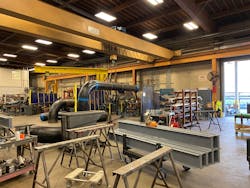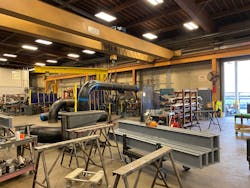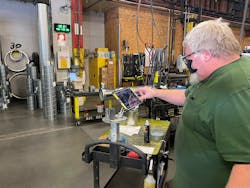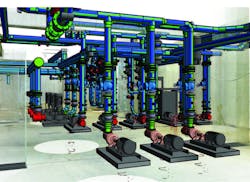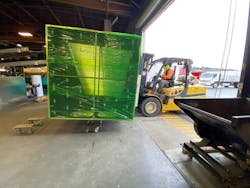Prefabrication and modular construction have been trending, and according to the pre-COVID Dodge Data & Analytics SmartMarket Report, “Prefabrication and Modular Construction 2020,” prefabrication and modular construction are poised to transform several sectors of the construction industry.
The Dodge report shows that architects, engineers and contractors that have used these methods plan to significantly increase their engagement with them, especially for healthcare facilities, hotels and motels, multifamily projects, and college buildings and dormitories. Critical trends in the construction industry, such as shorter project schedules and workforce shortages, are several drivers of wider use of these methods, and technology—like building information modeling (BIM)—is enabling increased use.
Take MacDonald-Miller Facility Solutions, Seattle, a full-service, design-build mechanical contractor in the Pacific Northwest, whose primary fabrication shop is 80,000 sq. ft. of indoor space and 100,000 sq. ft. of outdoor space, and two additional project-specific prefabrication locations near its shop for large assemblies and storage. Its shop prefabricates duct assemblies, mechanical piping, plumbing kits/assemblies, equipment skids and modular racks. “Our prefabrication space has virtually tripled in the last year to accommodate some large prefab-heavy projects we are working on,” says Rylan MacCay, operations manager, MacDonald-Miller Facility Solutions.
“We’ve always been on the progressive side of prefabrication, our first modular racks were over 10 years and the amount of prefabrication continues to increase—for new construction projects we typically have 70%-90% of the materials run through our shop,” says MacCay.
Meanwhile, Hill Mechanical, located just outside Chicago, has dabbled in prefab and modular construction for nearly a decade. “We have seen an increase growth in the modular industry over the last eight years. Healthcare has been one of the largest contributors to this increase along with the data centers. As more owners understand the benefits, more of the industry is looking for modular opportunities on each project,” says Kari Holtz, project manager, Hill Construction.
When evaluating a modular project, Hill Construction is looking at what items have the potential to benefit the schedule. Typically, the prefabricated units are being built while site work and MEP overhead is being installed. “When creating a schedule this means a portion of the finishes will be done significantly earlier that what a traditional build method would see. The time savings that comes from being able to move up the finishes results in the owners being able to open their building earlier which results in the overall costs savings,” says Holtz.
On the supply side, manufacturers like Aquatherm are realizing the value of prefabbed piping assemblies. “Our prefabrication team has seen a vast increase in orders, both in terms of size and scope. We have continued to invest in our team and tooling to meet the demands of our customers,” says Barry Campbell, vice president of marketing, Aquatherm.
The COVID Effect
Prefabrication was increasing in popularity prior to COVID as a way to reduce risk and shorten project schedules. Now that projects are ramping back up after almost a year of COVID delays, says Mark Gilbert, vice president, Victaulic, the industry is looking for ways to make up ground on delayed schedules, and prefab and modularization are viable tools to shorten the entire construction timeline. “Prefab allows contractors to do more with less—what was once a two-person job can now be a one-person job, limiting jobsite density and making it easier to adhere to social distancing requirements,” says Gilbert.
“Navigating through COVID-19 was a challenge for all areas of our business,” says MacCay. “To support our healthcare and essential facilities, our shop had to stay open since the beginning and throughout all phases of the pandemic. We implemented strict distancing, mask, and sanitation requirements. To support these requirements, we staggered all of our breaks and added a third shift—we were already working two—to reduce density and make it easier to social distance.”
Aquatherm and its Prefabrication and Operations teams have done a masterful job of navigating the COVID-related challenges that seemed to change not only by the day, but by the hour. “Our safety committee has consistently adapted to ensure that CDC and local recommendations are followed. Fortunately, our fabrication process and production floor lend themselves to a lot of work that can be done by one person isolated from coworkers, and we have enacted all the CDC recommended precautions regarding PPE and distancing,” says Campbell.
Advanced Technology
According to MacCay, the expansion of BIM and Robotic Total Station Layout is what allows MacDonald-Miller to increase its prefabrication volume. Both an accurate 3D model and the ability to precisely install are needed to make sure the systems will come together successfully in the field.
The company is also leveraging software to digitize its processes. “Digitizing how we work allows us to streamline processes, which reduces labor, lead time and increases accuracy. As we look toward the future, we are evaluating robotics, cobots (collaborative robots), augmented reality tools—like Spectar 2.0 with Microsoft HoloLens—to improve quality, optimize our workflows and leverage computer vision with AI for counting and quality control,” says MacCay.
According to Victaulic’s Gilbert, the adoption of 3D scanning has allowed traditional retrofit projects to embrace prefabrication as a worthwhile option, compared to the typical onsite cut and fit approach, thus reducing time on the jobsite for projects with already shortened shut-down and/or maintenance schedules. In addition, having the ability to improve the connection between the virtual design and construction (VDC) team and the fabrication shop is something many contractors now see as a competitive advantage.
In the past, a building model was converted to paper or PDF documentation. From those documents, fabrication details would be entered in the contractor’s systems and processes, continues Gilbert. Now, with the ability to easily connect the data in the model with manufacturing tooling like plasma cutters, pipe cutters and connected assembly stations, the limitations of PDF workflows have been removed, and the time it takes to go from design to fabrication has never been shorter. This does put more responsibility on the VDC team to get the details right and to have an accurate model with the best content.
Furthermore, "When your modeling software can deliver the scope change to estimating software automatically, and when either your estimators or VDC folks have visibility into the supply chain's price/availability without having to pick up a phone,” says Trimble’s Keane, “they can make a stronger decision earlier in the process.
“These contractors are truly positioned to break the historical stick building molds of mechanical construction and become an agile fabrication, rigging and installation company. The contractors who build data-driven workflows that support a manufacturing and procurement mindset are the most insulated from risk, and by far the most profitable.
“What really separates a great prefabrication plan from a good one is being agile enough to change or modify as external issues arise. It is so common that changes are imposed on plans that are already in-flight due to jobsite conditions, construction sequence or schedule, system performance criteria, or delays in the supply chain.
“Contractors that have developed workflows that allow them to pivot quickly, and never yield their control on engineering, logistics and cost are poised to outperform those who have siloed workflows,” says Keane.
